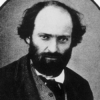Paul Cezanne

Paul Cezanne
Paul Cézannewas a French artist and Post-Impressionist painter whose work laid the foundations of the transition from the 19th-century conception of artistic endeavour to a new and radically different world of art in the 20th century. Cézanne's often repetitive, exploratory brushstrokes are highly characteristic and clearly recognizable. He used planes of colour and small brushstrokes that build up to form complex fields. The paintings convey Cézanne's intense study of his subjects...
NationalityFrench
ProfessionPainter
Date of Birth19 January 1839
CityAix-en-Provence, France
CountryFrance
Right now a moment of time is fleeting by! Capture its reality in paint! To do that we must put all else out of our minds. We must become that moment, make ourselves a sensitive recording plate...Give the image of what we actually see, forgetting everything that has been seen before our time.
Drawing and color are by no means two different things. As you paint, you draw... When color is at its richest, form is at its fullest.
Taste is the best judge. It is rare. Art only addresses itself to an excessively small number of individuals.
Pure drawing is an abstraction.
The Louvre is the book in which we learn to read. We must not, however, be satisfied with retaining the beautiful formulas of our illustrious predecessors. Let us go forth to study beautiful nature, let us try to free our mids from them, let us strive to express ourselves according to our personal temperaments. Time and reflection, moreover, little by little modify our vision, and at last comprehension comes to us...
Shut your eyes, wait, think of nothing. Now, open them ... one sees nothing but a great coloured undulation. What then? An irradiation and glory of colour. This is what a picture should give us ... an abyss in which the eye is lost, a secret germination, a coloured state of grace ... loose conciousness. Descend with the painter into the dim tangled roots of things, and rise again from them in colours, be steeped in the light of them.
May I repeat what I told you here: treat nature by means of the cylinder, the sphere, the cone, everything brought into proper perspective so that each side of an object or a plane is directed towards a central point. Lines parallel to the horizon give breadth... lines perpendicular to this horizon give depth. But nature for us men is more depth than surface, whence the need to introduce into our light vibrations, represented by the reds and yellows, a sufficient amount of blueness to give the feel of air.
Optics, developing in us through study, teach us to see.
To paint is not to copy the object slavishly, it is to grasp a harmony among many relationships.
The painter must enclose himself within his work; he must respond not with words, but with paintings.
Here, on the river's verge, I could be busy for months without changing my place, simply leaning a little more to right or left.
I am more a friend of art than a producer of painting.
I could paint for a hundred years, a thousand years without stopping and I would still feel as though I knew nothing.
If isolation tempers the strong, it is the stumbling-block of the uncertain.